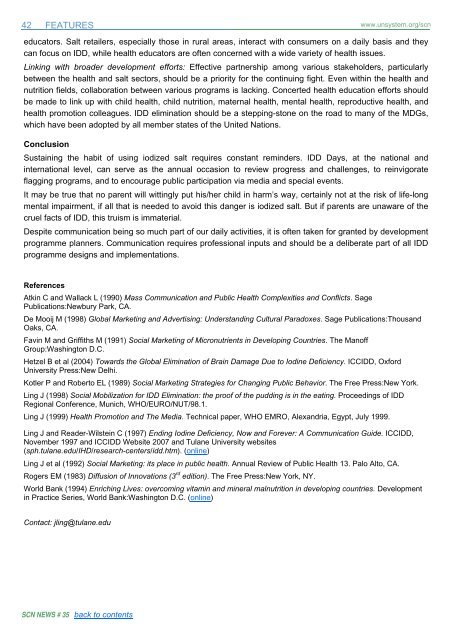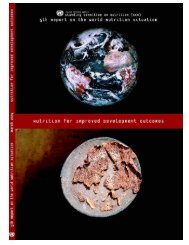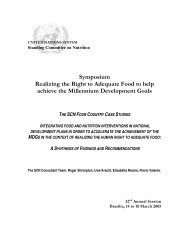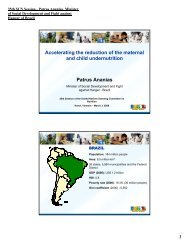42FEATURESwww.unsystem.org/scneducators. <strong>Salt</strong> retailers, especially those in rural areas, interact with consumers on a daily basis and theycan focus on IDD, while health educators are often concerned with a wide variety of health issues.Linking with broader development efforts: Effective partnership among various stakeholders, particularlybetween the health and salt sectors, should be a priority for the continuing fight. Even within the health andnutrition fields, collaboration between various programs is lacking. Concerted health education efforts shouldbe made to link up with child health, child nutrition, maternal health, mental health, reproductive health, andhealth promotion colleagues. IDD elimination should be a stepping-stone on the road to many of the MDGs,which have been adopted by all member states of the United Nations.ConclusionSustaining the habit of using iodized salt requires constant reminders. IDD Days, at the national andinternational level, can serve as the annual occasion to review progress and challenges, to reinvigorateflagging programs, and to encourage public participation via media and special events.It may be true that no parent will wittingly put his/her child in harm’s way, certainly not at the risk of life-longmental impairment, if all that is needed to avoid this danger is iodized salt. But if parents are unaware of thecruel facts of IDD, this truism is immaterial.Despite communication being so much part of our daily activities, it is often taken for granted by developmentprogramme planners. Communication requires professional inputs and should be a deliberate part of all IDDprogramme designs and implementations.ReferencesAtkin C and Wallack L (1990) Mass Communication and Public Health Complexities and Conflicts. SagePublications:Newbury Park, CA.De Mooij M (1998) Global Marketing and Advertising: Understanding Cultural Paradoxes. Sage Publications:ThousandOaks, CA.Favin M and Griffiths M (1991) Social Marketing of Micronutrients in Developing Countries. The ManoffGroup:Washington D.C.Hetzel B et al (2004) Towards the Global Elimination of Brain Damage Due to Iodine Deficiency. ICCIDD, OxfordUniversity Press:New Delhi.Kotler P and Roberto EL (1989) Social Marketing Strategies for Changing Public Behavior. The Free Press:New York.Ling J (1998) Social Mobilization for IDD Elimination: the proof of the pudding is in the eating. Proceedings of IDDRegional Conference, Munich, WHO/EURO/NUT/98.1.Ling J (1999) Health Promotion and The Media. Technical paper, WHO EMRO, Alexandria, Egypt, July 1999.Ling J and Reader-Wilstein C (1997) Ending Iodine Deficiency, Now and Forever: A Communication Guide. ICCIDD,November 1997 and ICCIDD Website 2007 and Tulane University websites(sph.tulane.edu/IHD/research-centers/idd.htm). (online)Ling J et al (1992) Social Marketing: its place in public health. Annual Review of Public Health 13. Palo Alto, CA.Rogers EM (1983) Diffusion of Innovations (3 rd edition). The Free Press:New York, NY.World Bank (1994) Enriching Lives: overcoming vitamin and mineral malnutrition in developing countries. Developmentin Practice Series, World Bank:Washington D.C. (online)Contact: jling@tulane.eduSCN NEWS # 35 back to contents
www.unsystem.org/scn FEATURES 43Achieving and Sustaining <strong>Universal</strong> <strong>Salt</strong> <strong>Iodization</strong> (<strong>USI</strong>):Doing It Well Through Regulation and Enforcement. Lessons Learned from <strong>USI</strong> in NigeriaDora N. Akunyili (Director General, National Agency For Food and Drug Administration and Control (NAFDAC), Nigeria)Abstract: Prior to 1993, Iodine Deficiency Disorders (IDD) were recognized as a public health problem in Nigeria. Followinga series of international summits, meetings and resolutions, Nigeria initiated its <strong>USI</strong> program, deriving momentumfrom three key success factors; political commitment by government, commitment by salt industry and effective multisectoralpartnership. In 1993, <strong>Universal</strong> <strong>Salt</strong> <strong>Iodization</strong> (<strong>USI</strong>) law was enacted and made mandatory in Nigeria. Within aperiod of five years access to adequately iodized salt had grown from a zero base in 1993 to reach an impressive levelof 98% of Nigeria’s households by 1998. This has been further sustained through aggressive enforcement by governmentand compliance by the salt industry, and Nigeria currently ranks high on global and regional report cards. In 2005,the goitre rate was 6.2%, down from 20% in 1993. Median Urinary Iodine excretion rate has consistently been over 130μg/dl since 1999. Improvements in urinary iodine excretion and goitre rates have been substantive. In addition, the 10point criteria for <strong>USI</strong> certification have consistently been met, which paved way for Nigeria’s certification as the firstcountry in Africa to achieve <strong>USI</strong> compliance in 2005 by the Network for Sustained Elimination of Iodine Deficiency. Thispaper summarizes Nigeria <strong>USI</strong> programme strategies and actions in hopes of assisting countries that have yet toachieve <strong>USI</strong>.Key words: Enforcement, fortification, IDD, iodization, monitoring, Nigeria, partnership, regulation, salt, universal, <strong>USI</strong>IntroductionIodine deficiency is the single most common cause of preventable mental retardation and brain damage inthe world. It is a major health problem in many parts of the world. IDD causes goitres and decreases theproduction of hormones (T 4 and T 3 ) vital to growth and development. In pregnant women, IDD causes mentalretardation or cretinism with possible physical disability in children, and can also lead to miscarriage or stillbirth. Children with IDD can grow up stunted, mentally retarded and incapable of fast learning. Children iniodine depleted populations can have an Intelligent Quotient (IQ) of 10-15 percentage points lower than thoseof iodine replete populations. The reduction in IQ is irreversible.Prior to 1993, Iodine Deficiency Disorders (IDD) were recognized as a public health problem in Nigeria. In2005, the goitre rate was 6.2%, down from 20% in 1993. Median Urinary Iodine excretion rate has consistentlybeen over 130 μg/dl since 1999. Although IDD were recognized as a public health problem in Nigeriafor over four decades (Ekpechi 1967), efforts to establish an IDD control programme in Nigeria only gatheredmomentum after a number of global summits and meetings had been held, in particular, the World Summit forChildren in New York (1990), the Policy Conference on Ending Hidden Hunger in Montreal (1991), theInternational Conference on Nutrition (ICN) in Rome and its subsequent resolutions (1992), the Organizationof African Unity (OAU) sponsored Dakar Consensus of1994, and the African Union (AU) Member StatesSummits in Addis Ababa (1995) and Cairo (1996). In 1992, a multi-sectoral consensus-building workshopwas held in Nigeria on the need to establish <strong>Universal</strong> <strong>Salt</strong> <strong>Iodization</strong> (<strong>USI</strong>) program. Since the <strong>USI</strong> law wasenacted in 1993, Nigeria managed—within a period of five years—to increase household access to adequatelyiodized salt from a zero base to an impressive level of 98% already in 1998. Table 1 shows a summaryof results of the national assessment of the Nigeria <strong>USI</strong> programme from 1988 to 2005.Nigeria programme strategiesNigeria's success is mainly a result of three factors that have fostered and combined regulation, enforcementand compliance to the <strong>USI</strong> law: First, political commitment by government to regulation, enforcement andsocial marketing; Second, commitment by the salt industry; and, third, effective multi-sectoral partnership.Political commitment by government to regulation, enforcement and social marketing<strong>Salt</strong> <strong>Iodization</strong> was established by law in 1993 in Nigeria and made mandatory. The law (Nigeria IndustrialStandard, NIS, 168:1992) stipulates that all food grade salt be fortified at 50ppm at ports and factories,30ppm at retail. This was followed by the agreement and launch (by the Vice President of Nigeria) of a <strong>USI</strong>logo for ease of identification of all iodized salt and for communication purposes (Figure 2). The Law is enbackto contents SCN NEWS # 35







